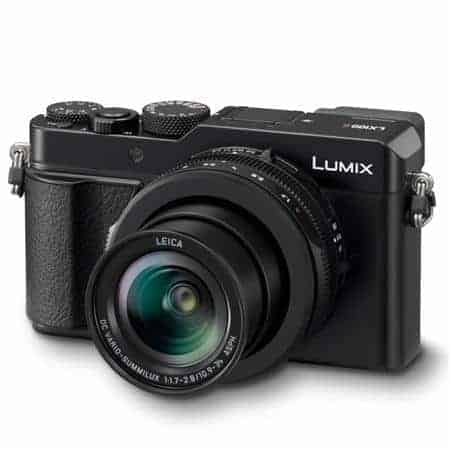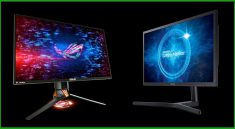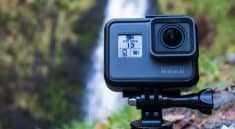Looking for a new compact camera? We have reviewed the 10 best compact cameras:
Compact cameras and the compact camera market have changed significantly in recent years. Smartphones have decimated the entry-level “Point and Shoot” models that were once popular and, as a result, manufacturers have focused on introducing more advanced features and options into cameras to make them more appealing. So in the end, you benefit!In addition to having physically larger sensors to improve image quality that can compete with DSLRs in some cases, some compact cameras have a lens with a wide zoom range or maximum apertures. Wi-Fi connectivity has also become standard on most compacts, allowing you to quickly upload photos to a phone for sharing on Facebook, and more.
Best compact cameras
- Fujifilm X100F
- Panasonic Lumix ZS100 / TZ100
- Panasonic Lumix LX100
- Panasonic Lumix LX10 / LX15
- Canon PowerShot G9 Mark II
- Sony RX100 V
- Panasonic Lumix FZ2000 / FZ2500
- Sony R X10 III
- Sony WX220
- Leica Q
Many enthusiastic photographers used to be very cautious about the use of compact digital cameras, but the range and features have improved so much that they now are a great alternative to a DSLR or a mirror less camera. And those who are new to photography and who are thinking of getting rid of a smartphone camera are also spoiled for choice
These are small cameras that can fit in the pocket, but have huge zoom ranges, and large bridge devices resembling DSLRs but having a fixed lens as well as many easy-to-use automated options.
These devices prove that you do not have to buy a camera with interchangeable lenses to get great pictures.
If you need a little more help finding the type of camera you need, read this article: Which camera should I buy?
Or if you already know what kind of camera you want, then check out our more specific compact camera guides:
- Best Bridge Camera
- Best travel camera
- Best cheap camera
- Best waterproof camera
If not, keep reading this article to find out which are the best compact cameras on the market today, and why.
1. Fujifilm X100F
The Fujifilm X100F is the perfect compact for passionate photographers.

- Sensor : APS-C CMOS, 24.3MP
- Lens: 23 mm f / 2
- Monitor: 3.0 inches, 1,040,000 points
- Viewfinder: Hybrid Optics / EVF
- Continuous shooting: 8 frames / second
- Movies: 1080p
User Level: Expert
Hybrid viewfinder
Fixed focus lens
This is perhaps one of the more expensive options on the market and it’s not necessarily a compact for everyone, but if you’re looking for a high quality camera, you will not be disappointed with the Fujifilm X100F. Everything inspires class and elegance.
Unlike many compacts presented here, it has a fixed lens as opposed to a zoom lens, but this 35mm f / 2.0 equivalent is paired with a 24.3 MP APS-C sensor the size of a digital SLR that delivers amazing results. It also has external touch controls and a smart hybrid viewfinder – you have the option of electronic and optical views that make it a pleasure to take pictures.
You will need some photo knowledge to get the most out of your shots, but the Fujifilm X100F is an exquisite device.
2. Panasonic Lumix ZS100 / TZ100
The Panasonic Travel Camera is equipped with a larger sensor than the rest of the others in this category.

- Sensor: 1 inch, 20.1MP
- Lens: 25-250mm, f / 2.8-5.9
- Monitor: 3.0-inch touch screen, 1,040,000 points
- Viewfinder: EVF
- Continuous shooting: 10fps
- Movies: 4K
User Level: Beginner / Intermediate
Zoom x10 zoom lens
Fixed screen
Panasonic invented the travel camera category – compact cameras that can fit in a pocket, but have long, built-in zoom lenses. The ZS / TZ range continues to dominate sales despite strong competition.
However, the compact camera has evolved and Panasonic must do more to attract new buyers.
Its answer was to keep the camera case about the same size as the older TZ series cameras, while incorporating a much larger 1-inch sensor in the ZS100 (TZ100 outdoors). This allows the pixels to be about 2.4 times larger than they are in models such as the ZS50 / TZ70 and this helps the ZS100 to produce much better quality images.
3. Panasonic Lumix LX100
A masterpiece for a compact, with a large sensor, classic controls and a viewfinder.

- Sensor: Micro Four Thirds, 12.8MP
- Target: 24-75mm, f / 1.7-2.8
- Monitor: 3.0 inches, 921,000 points
- Viewfinder: EVF
- Continuous shooting: 11fps
- Movies: 4K
User Level: Intermediate / Expert
Traditional controls
Average resolution
Passionate photographers usually opt for a DSLR or a high end compact camera, but they also want a camera that slips into a pocket for times when the big camera has to stay at home.
Usually this means accepting a smaller sensor – but not this time. Panasonic has somehow integrated a CSC-sized Micro Four Thirds sensor into a compact camera body.
In addition, he added an aperture ring on the lens, a shutter speed dial on the top and an electronic viewfinder. It has a wide-aperture lens specifically designed for 4K shooting. The LX100 was expensive at the time of its launch, but the price has not stopped decreasing. It’s always a remarkable and unique device.
4. Panasonic Lumix LX10 / LX15
With a tough market competition, here is our selection of a compact camera with a one-inch compact (sensor). Small and Compact!

- Sensor: 1 inch, 20.1MP
- Lens: 24-72mm, f / 1.4-2.8
- Monitor: 3.0-inch touch screen, 1,040,000 points
- Viewfinder: No
- Continuous shooting: 6fps
- Movies: 4K
User Level: Beginner / Intermediate
Fast AF system
Lack of proper grip
Panasonic has managed to establish itself in the fast-growing one-inch high-end compact sector with the awesome Lumix LX10 (known as the LX10 outside of the US), and is the perfect balance between performance, features and prices.
The bad news – there is no built-in EVF and the smooth finish does not offer the best grip. However, but the 24-72mm lens is one of the fastest with an opening maximum of f / 1.4. Add to that a neat finish with two control rollers, a touch screen, fast autofocus and 4K video capture, and you get one of the best compact cameras on the market.
5. Canon PowerShot G9 X Mark II
A concentrate of technology for a compact camera

- Sensor: 1 inch, 20.1MP
- Lens: 28-84mm, f / 2-4.9
- Monitor: 3.0-inch touch screen, 1,040,000 points
- Viewfinder: No
- Continuous shooting: 8.2fps
- Video: 1080p
User Level: Beginner / Intermediate
Easy to use
No 4K video
Although there is now a decent selection of high quality 1.0 inch sensor compact cameras to choose from, the Canon PowerShot G9 X Mark II is distinguished by its discreet proportions and simplified controls. The extremely small dimensions mean that there are sacrifices to be made since the PowerShot G9 X Mark II has a relatively short focal length zoom lens.
However, if you’re looking for a neat compact camera that can produce better-than-your-smartphone images, and features great connectivity options with easy-to-use controls, the PowerShot G9 X Mark II is a great choice.
6. Sony RX100 V
Sony’s super-fast sensor technology is great … but expensive.

- Sensor: 1 inch, 20.1MP
- Lens: 24-70mm, f / 1.8-2.8
- Monitor: 3.0 inches, 1,228,800 points
- Viewfinder: EVF
- Continuous shooting: 24fps
- Movies: 4K
User Level: Intermediate / Expert
Integrated EVF
No touch screen
The first Sony RX100 was a reference device that fused a one-inch sensor into a compact metal case with the controls and image quality demanded by hobbyists.
The RX100 V goes further, however, with a “stacked” sensor for high-speed data capture. This means that it can shoot 4K video, 40x slow motion images, and 24fps still images in continuous burst mode. Not to mention the integrated small electronic viewfinder that is lacking to his opponents.
This is an expensive option, but if you’re looking for a versatile, compact pocket camera with a quality zoom lens, you will not be disappointed
7. Panasonic Lumix FZ2000 / FZ2500
The FZ2000 / FZ2500 combines a zoom of a Bridge camera with a large 1 inch sensor.

- Sensor: 1 inch, 20.1MPÂ
- Lens: 24-480mm, f / 2.8-4.5
- Monitor: 3.0 inch articulated, 1,040,000 points
- Viewfinder: EVF
- Continuous shooting: 12fps
- Movies: 4K
User Level: Intermediate
Super fast AF
No sealing
This trend towards larger sensors is illustrated with the Panasonic Lumix FZ2000 (known as the FZ2500 in the United States). Bridge cameras are very popular because they offer a colossal zoom range at a reasonable cost.
However, to design a big zoom, manufacturers must use a tiny sensor – and here Panasonic has made the wise choice to sacrifice the scope of the zoom for better quality. The Panasonic FZ2000 uses a one-inch sensor, and although the zoom is greater than 480mm (which is relatively short for a Bridge camera) it’s more than enough for use from the simplest to the most extreme.
We love the FZ2000 because it offers both image quality and a large zoom range – if you’re looking for something a little cheaper.
8. Sony R X10 III
Costly, but very powerful and offering a wide focal range.

- Sensor: CMOS 1 inch, 20.2MP
- Lens: 24-600mm, f / 2.4-4
- Monitor: 3.0 inches tilt-angle, 1.23 m points
- Viewfinder: EVF
- Continuous shooting: 14fps
- Movies: 4K
User Level: Intermediate / Expert
High quality zoom
The menu system could be better
Sony took the 24-200mm zoom lens from the RX10 II and put it on steroids, with a lens now covering a wide range for zooming from 24mm to 600mm. The f / 2.8 fixed aperture is, however, replaced by a f / 2.4-4 variable range, but for the extra range offered, it compensates for this loss.
The 1-inch, 20.1MP sensor is able to achieve an excellent level of detail, while the high ISO performance is also remarkable. The increased zoom range means that the RX10 III is even larger than its predecessors, but the handling is very neat (we would like the menu system to be a little more refined), providing the same sensations as a DSLR in hand and complemented by a large, bright electronic viewfinder. Not to mention the possibility of capturing videos in 4K.
9. Sony Cyber-Shot DSC-WX220
Cheap and friendly for a compact 10x device!

- Sensor: CMOS 1 / 2.3 inch, 18.2MP
- Lens: 25-250mm, f / 3.3-5.9
- Monitor: 2.7 inches, 460,000 points
- Viewfinder: No
- Continuous shooting: 1.5fps
- Movies: 1080p
User Level: Beginner
Compact design
Small screen
If you want a compact camera that can do a better job than your smartphone, the Sony Cyber-Shot DSC-WX220 meets these requirements, especially when you consider the added flexibility offered by 10x optical zoom, ranging from 25 to 250mm.
The images are brilliant and punchy, with decent details – great for sharing online or printing on standard-size media – while having the interesting choice of Wi-Fi connectivity. The 2.7-inch screen is a great slightly smaller than normal, but this keeps the camera’s dimensions in a pocket size. The WX220 may not have much in the belly, but what he does, he does it well.
10. Leica Q
It’s incredibly expensive, but the Q is the best compact camera on the market.

- Sensor: Full Image, 24.2 MP
- Objective: 28 mm f / 1.7
- Monitor: 3.0-inch touch screen, 1,040,000 points
- Viewfinder: EVF
- Continuous shooting: 10 frames / s
- Movies: 1080p
User Level: Expert
Note fast lens
Optional front handle
When the photograph had the same fundamentals as the film, most compact cameras took 35mm film, just like professional-level SLRs. It meant that if your camera had a correct lens, you could get brilliant results.
Digital photography has changed this and many compact cameras have much smaller sensors, which makes achieving high quality images more difficult.
Leica and Sony are the only companies that make a compact camera with a full-frame sensor and while the Sony RX1 models are great, the Leica Q (Typ 116) has captured our hearts.
The biggest drawback of Q is its price, there is no way to escape. But for this huge amount of money, you get a Leica Summilux 28mm f / 1.7 ASPH lens, a stunning electronic viewfinder with 3,680,000 dots, a 1040,000-dot 3-inch touch screen, fast autofocus, traditional exposure controls, and the ability to create breathtaking images.
Despite the price, Leica can not do enough Q to keep up with demand.
Still didn’t find what you are looking for? Check out our related articles such as Best Travel Cameras and Best Affordable Cameras.




